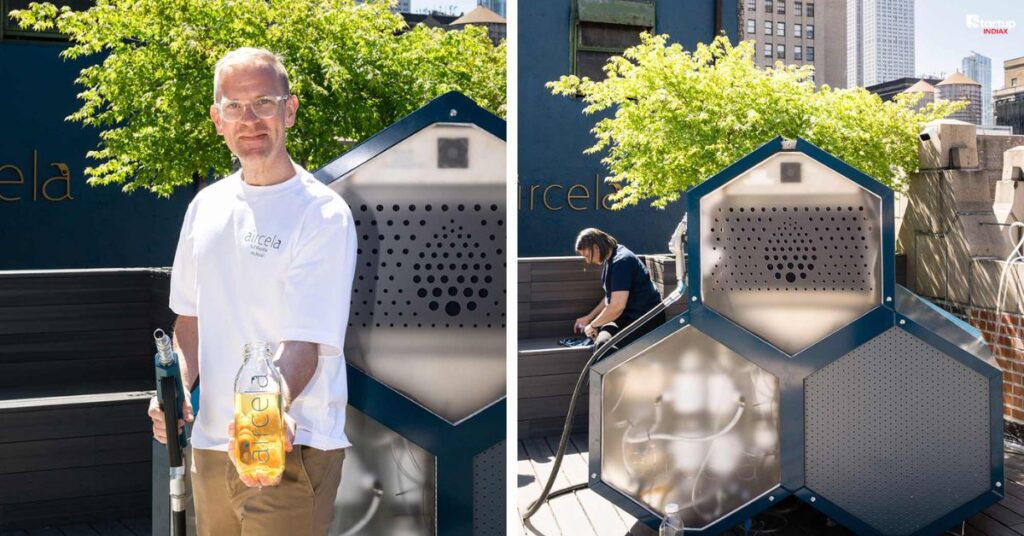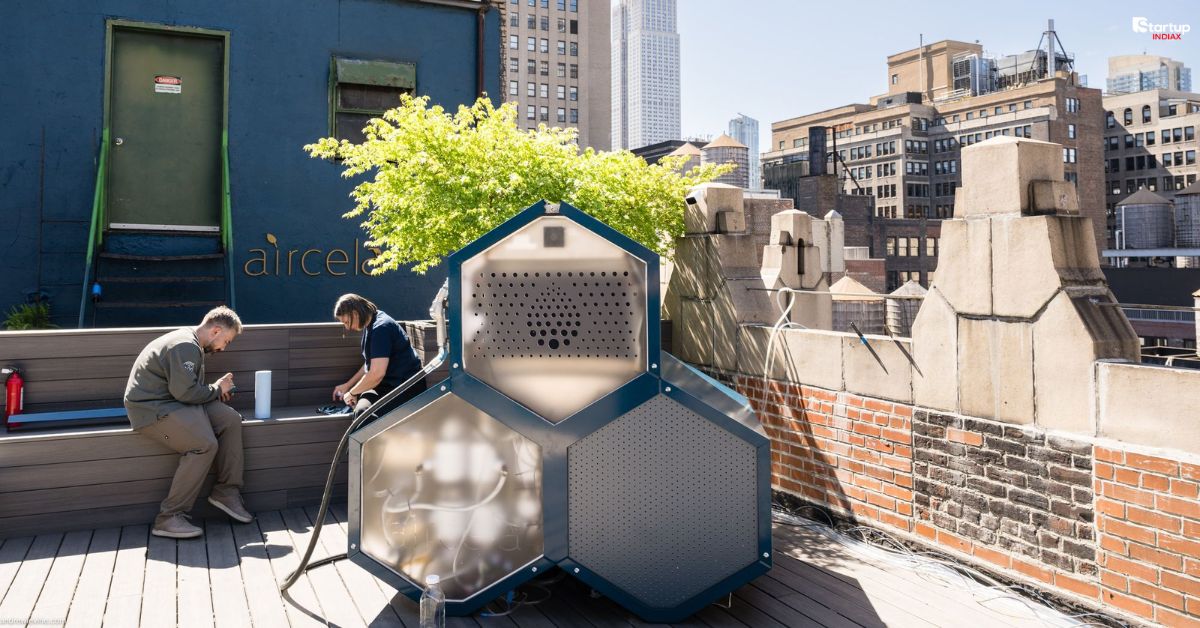Aircela’s air-to-fuel technology appears to be a groundbreaking innovation in sustainable energy, producing fossil-free gasoline from air, water, and renewable electricity. This technology aims to reduce carbon emissions while offering a scalable, engine-compatible fuel solution. In this article, we explore how Aircela’s system works, its potential to transform industries, and the challenges it faces in scaling up. As a trusted source for tech and startup insights, Startup INDIAX provides an in-depth look at this revolutionary development, helping entrepreneurs and professionals understand its implications for a cleaner energy future.
Table of Contents
Introduction: A New Era in Fuel Production
The race to combat climate change has sparked innovative solutions in sustainable energy. In May 2025, Aircela, a New York-based startup, unveiled a machine that could redefine how we produce fuel by creating gasoline directly from air, water, and renewable electricity. Demonstrated on a Manhattan rooftop, this technology has captured the attention of entrepreneurs, environmentalists, and industry leaders. Could Aircela’s air-to-fuel technology be the key to a fossil-free future? Let’s explore its mechanics, benefits, and potential impact.
What is Aircela’s Air-to-Fuel Technology?
Aircela’s air-to-fuel technology is a compact, modular system that transforms atmospheric carbon dioxide (CO2) into synthetic gasoline using water and renewable electricity. Unlike traditional fossil fuels, this gasoline is fossil-free and designed to be carbon-neutral, meaning the CO2 emitted during combustion is offset by the CO2 captured during production. The fuel is compatible with existing engines, requiring no modifications to vehicles or infrastructure.

Founded in 2019 by Mia and Eric Dahlgren, Aircela has attracted investment from Maersk Growth, signaling strong industry confidence. The prototype, roughly the size of a large refrigerator, was showcased in May 2025 as the first working machine in the U.S. to produce gasoline directly from air .
How Does Aircela’s Technology Work?
Aircela’s machine integrates three key processes within hexagonal modules, inspired by honeycomb designs for efficiency and aesthetics. Here’s a breakdown of the process:
How Does It Capture CO2 from the Air?
The first module uses a liquid sorbent solution to capture CO2 directly from the atmosphere through direct air capture (DAC). This reusable solution ensures sustainability and cost-effectiveness. DAC is a proven technology, with companies like Carbon Engineering advancing similar approaches for large-scale applications .
How Does Electrolysis Contribute to Fuel Production?
The second module employs electrolysis to split water into hydrogen and oxygen. The hydrogen is stored for fuel synthesis, while the oxygen is released into the atmosphere. This step relies on electricity, ideally from renewable sources like solar or wind, to maintain the process’s environmental benefits.
How Is the Fuel Synthesized?
In the final module, captured CO2 and hydrogen are combined to produce methanol, which is then converted into gasoline through a methanol-to-gasoline (MTG) process. The resulting fuel is free of sulfur, heavy metals, and ethanol, offering a cleaner alternative to conventional gasoline.
This integrated system enables on-site fuel production, reducing reliance on centralized refineries and complex supply chains.
What Are the Benefits of Aircela’s Technology?
Aircela’s technology offers several advantages that could reshape the energy landscape.
Can It Reduce Carbon Emissions?
By capturing CO2 from the air, Aircela’s process helps reduce net carbon emissions. When powered by renewable energy, it can be carbon-neutral or even carbon-negative, actively removing CO2 from the atmosphere. The fuel’s purity—free from sulfur and additives—further reduces harmful emissions .
Is It Scalable and Flexible?
The modular design allows multiple units to be linked, enabling scalability for both small and large applications. Its compact size makes it ideal for deployment in remote or off-grid locations, reducing transportation costs and logistical challenges.
Does It Work with Existing Infrastructure?
Unlike alternative fuels requiring engine modifications or new infrastructure, Aircela’s gasoline is fully compatible with existing vehicles and fueling systems. This compatibility makes it a practical solution for widespread adoption without disrupting current practices.
What Challenges Does Aircela’s Technology Face?
Despite its promise, Aircela’s technology faces hurdles that could impact its adoption.
Is Production Capacity a Limiting Factor?
The current prototype produces approximately one gallon (4.55 liters) of gasoline per day when operating continuously [1]. While significant for a prototype, this output is modest compared to traditional refineries, limiting its immediate impact.
Are Costs a Barrier to Adoption?
Scaling production to meet global demand requires significant investment. Current costs are high, and reducing them is critical for commercial viability. Aircela aims to address this through technological advancements and economies of scale.
Does It Depend on Renewable Energy?
The technology’s carbon-neutral status relies on renewable electricity. If powered by non-renewable sources, its environmental benefits diminish, underscoring the need for accessible and affordable clean energy.
How Could Aircela Shape the Future of Energy?
Aircela’s technology holds significant potential for transforming the energy sector.
Can It Decarbonize Transportation?
Industries like aviation, shipping, and heavy transport, where electrification is challenging, could benefit significantly. Aircela’s fossil-free gasoline aligns with global climate goals, with investors like Maersk seeing potential for sustainable shipping [4].Is It Suitable for Remote Areas?
The compact, modular design makes Aircela’s machines ideal for remote locations, such as rural communities or industrial sites, where traditional fuel supply chains are costly or impractical. This could enhance energy security and accessibility.
Will It Achieve Mass Adoption?
As production scales and costs decrease, Aircela’s technology could become a viable alternative to fossil fuels. Its compatibility with existing infrastructure positions it as a practical solution for transitioning to a low-carbon economy without requiring significant consumer behavior changes.
What’s Next for Aircela’s Technology?
Aircela plans to begin deployments in fall 2025, targeting off-grid, commercial, and industrial users. The company aims to increase production capacity, reduce costs, and expand availability. CEO Eric Dahlgren stated, “We didn’t build a prototype. We built a working machine,” emphasizing their focus on practical solutions. Collaborations with industry leaders like Maersk and research from institutions like Cambridge University will support Aircela’s efforts to refine and scale the technology. Startup INDIAX will continue to track Aircela’s progress, delivering updates on this transformative innovation.
Conclusion: A Game-Changer in Sustainable Energy
Aircela’s air-to-fuel technology offers a promising path toward a fossil-free energy future. By producing clean gasoline from air, it addresses carbon emissions while leveraging existing infrastructure. Though challenges like limited production capacity and high costs remain, its potential to decarbonize transportation and enhance energy access is significant. As Aircela moves toward commercial deployment, this technology could redefine how we power our world.
What are your thoughts on Aircela’s air-to-fuel technology? Could it shape the future of sustainable energy? Share your opinions in the comments, spread the word, and explore more innovative startup stories on Startup INDIAX.
FAQs
How does Aircela’s technology capture CO2 from the air?
Aircela uses a liquid sorbent solution in its carbon capture module to extract CO2 directly from the atmosphere. The solution is reusable, ensuring efficiency and sustainability.
Is the fuel produced by Aircela truly carbon-neutral?
When powered by renewable electricity, the fuel is carbon-neutral, as the CO2 emitted during combustion matches the CO2 captured during production. Non-renewable energy sources reduce this benefit.
Can this technology produce other types of fuel?
While currently focused on gasoline, the technology could potentially be adapted to produce other synthetic fuels, such as diesel or jet fuel, by modifying the synthesis process.
What are the main advantages of Aircela’s technology over traditional fuel production?
It reduces carbon emissions, enables on-site production, is compatible with existing engines, and supports decentralized fuel production, enhancing energy security.
When will Aircela’s technology be commercially available?
Aircela plans to deploy its machines in fall 2025 for off-grid, commercial, and industrial use. Widespread availability may take longer as production scales and costs decrease.

